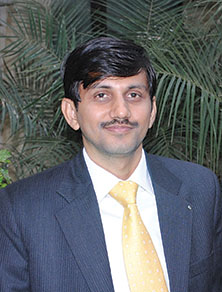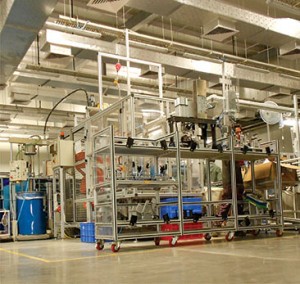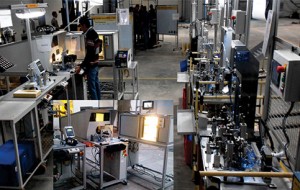Hella India Lighting is developing customisable LED headlamps for commercial vehicles.
Story by: Anirudh Raheja
LED automotive lighting offers a distinct advantage over conventional lighting. LED consume less power and last longer than an incandescent bulb would. Especially in the case of an automobile, which could be subjected to rough road conditions quite often, and long hours of service. Hella India Lighting (HIL), the Indian subsidiary of German automotive lighting specialist Hella, has been developing LED based headlamps for commercial vehicles. “By early next year, you will be able to see semi-customisable projector headlamps for the Commercial Vehicle (CV) industry from Hella in the Indian market,” says HIL’s managing director Ramashankar Pandey. With the cost of developing new LEDs decreasing, Pandey feels that it is time the industry takes to LED technology at a higher pace. “Projector modules have mass customisation manufacturing philosophy. With the same proje ctor modules, we can develop different lamps by changing the design and bezel around it and fulfill the demands,” he adds.
ctor modules, we can develop different lamps by changing the design and bezel around it and fulfill the demands,” he adds.
With the demand for standard post card headlamp designs refusing to fade despite the their lack of ability to address the changing lighting needs of commercial vehicles, compelling commercial vehicle operators to fit extra lights for better illumination, faster adoption of LED lighting will prove to be beneficial. It will also reduce the risk of haphazard aftermarket modifications that run the risk of a short circuit and subsequent damage that is often costly. “Adoption of technology in the CV industry is slow, and even though the industry is not shy,” remarks Pandey. He draws attention to his company supplying LED tail lights to the Ashok Leyland Boss last year. “These lighting equipment are based on Poke Yoke technology to give more response time during braking and remains active even if the vehicle is parked on the road side to reduce fatalities on the road,” avers Pandey. Hella is also a prime supplier of LED lights to the Ashok Leyland Janbus and many other coach makers in the country. Stress initially, said Pandey, was laid on promoting the LED lighting technology to coach builders. Emphasis on promoting the technology to trucks followed. Next came the tractors. Interestingly, it is the tractor industry that has been more keen to adopt LED lighting. Pandey revealed that two projects with leading tractor manufacturers in India are already underway on an experimental basis, and the products are expected to be launched in the next six months. Hella, it is clear, does not want to miss out on any sector. It does not come as a surprise therefore, when Pandey explains that his company is also planning a foray into two-wheeler lighting solutions. “By mid next year, based on the prototypes developed and discussions had with leading OEMs, the two-wheeler market will see our products based on projector modules and LEDs,” exclaimed Pandey.
Hella entered India in 1959 with the launch of the first truck by Tata in collaboration with Mercedes-Benz. The Tata 1210 flaunted Hella lights. Having come to command a leading position in automotive lighting, and as a leading supplier of lighting solutions to OEMs in India, HIL’s Derabassi plant churns out 1.48 million LED units annually. The plant also turns out 0.85 million units of headlamps and 0.76 million units of projector modules, and similar units of tail lamps as well. Opines Pandey that it is important to serve quality products irrespective of whether they are aimed at an OEM or at the aftermarket. It was not long ago that HIL undertook a complete renovation of the Derabassi plant. It installed moulding machines, metalising processes in a dust free environment to churn out products with enhanced surface coating to ensure that they have a long life.
Aftermarket thrust
Operating under three verticals, Hella India Lighting, Hella India Automotive and Hella Independent Aftermarket, the German tier 1 supplier is applying an amount of aftermarket thrust. It is going to the length of setting up a completely different vertical for aftermarket to harness the potential. Hella has joined hands with Mahle Behr to diversify into thermal business and churn out radiators, relay, flashers and engine cooling systems. In 2014, the company renovated the plant at Dhankot, which operates under the Hella India Automotive vertical to setup SMT lines for Remote Keyless Entry (RKE) and Body Control Module (BCM) for passenger cars. Passenger cars and commercial vehicles contribute equally to HIL’s revenue in India according to Pandey, and despite the passenger car parc being higher in numbers. Stressing upon the faster chrun out rate of commercial vehicle spares, Pandey explains that this also increases the possibility of piracy. “Our legal structure does not make for good enforcement. There’s a law in India for safety critical product to adhere to the AS standard for the aftermarket. The AS standard also applies to OEM. Its enforcement needs to be strictly carried out,” he adds. Pandey is optimistic of the situation changing. “The silver lining is the new safety bill, which will be quite stringent and there will be more emphasis on the fitness of the vehicle on the road rather than in the lab,” he mentions.
HIL is not waiting for the safety bill to turn into a law. The company frequently organises public debates and meetings with mechanics and electricians to create awareness regarding the use of original parts. “We have created an NGO to do mass education to teach drivers, fleet owners; we are also conducting campaigns at toll booths in close cooperation with the National Highway Authority of India (NHAI), Automechanika and ACMA to create awareness,” says Pandey. In order to curb the problem of piracy, HIL is making efforts to reach out to the customers directly. The company has installed hotlines and a mobile App. to facilitate warranty registration of its products. “This,” claims Pandey, “helps to understand the presence of spurious products.” The traditional method of conducting raids is not technically feasible anymore, he quips.
Out of the 30,000 people Hella employs in India, 6,000 work in the R&D. The company has invested in an engineering centre at Chennai, and in a Global Product Development Centre at Chakan, Pune. The two centres work closely with their international counterparts to develop new products. According to Pandey, this helps them to stay competitive. “To arrive at a cost competitive structure in India for LED lamps, we received a lot of support from our New Zealand centre,” Pandey remarks. Currently, over 30 per cent of Hella’s earnings come from the commercial vehicle business. These are expected to grow with most global commercial vehicle manufacturers investing in India. To ensure visibility, Hella has appointed over 12,000 retailers and 150 distributors in India. “We are technically ready, and it is just about creating awareness. It is time we should look out for certified products and progress towards a better future” Pandey signs off.





















